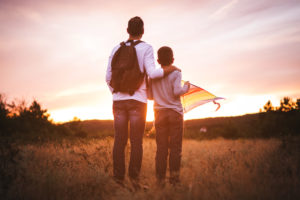 Asking a parent not to panic when their child discloses sexual abuse may seem unreasonable. Anger is a natural reaction to news like this, but it may not be the response that best serves your child in the moment. Children tend to associate anger with wrongdoing, and the last thing you want is for your child to think they’ve done something wrong.
Asking a parent not to panic when their child discloses sexual abuse may seem unreasonable. Anger is a natural reaction to news like this, but it may not be the response that best serves your child in the moment. Children tend to associate anger with wrongdoing, and the last thing you want is for your child to think they’ve done something wrong.
Regardless of whether the abuse was alleged to have been perpetrated by another child or an adult, there are things you can do to slow the runaway train of emotions you feel and to approach the situation with a plan.
1. Do not overreact.
Your child is coming to you in a time of need—they need your calm, strength, and composure. It’s okay for your child to see you upset, but try not to become overwhelmed to the point of loss of control. Your child is likely feeling powerless over their own life and body, so your self-control is important not only for you but also for your child.
2. Calmly ask for more information.
While keeping your composure, ask your child what happened and with whom in a non-leading way. Your child will tell you what you need to know. Don’t force it—you do not want to retraumatize your child by having them retell the experience before they are emotionally able to go there. Keep in mind some sexual behaviors are normal for children and do not necessarily mean abuse. However, abused children may act out their experiences on themselves or others. It is important to understand what is normal and what is a red flag for sexual abuse.
3. Stay in the moment with your child.
Abused children often feel guilt or responsibility for what happened to them. They may think they deserved the abuse or allowed it to happen. Be emotionally present with your child and reassure them that they are not at fault. Children cannot consent to sexual situations and are never to blame for their abuse. Validation of their emotions and feelings is critical after disclosure.
4. Be on the same page.
Often when a family learns of a child’s abuse, chaos ensues. One adult may want to pursue legal action, while another may want to wait to involve police. Discussion and consensus among caregivers helps ensure there is no extra stress or emotional turmoil within the home in the weeks after disclosure. If caregivers are on the same page and agree to a plan of action, the child is less likely to take on the stress and uncertainty, which could result in self-blame.
Be emotionally present with your child and reassure them that they are not at fault. Children cannot consent to sexual situations and are never to blame for their abuse.
5. Do not force your child to see the alleged perpetrator.
The vast majority of children who have been sexually abused experienced the abuse at the hands of someone known to the family. Whether it’s a family member, friend, coach, teacher, or someone else, continued contact between the child and the alleged abuser may only retraumatize the child. It may be challenging in some cases to keep the child from the abusive person, especially if they are family, but do not force your child to be exposed to this person. The weeks and months after disclosure is a fragile time, and your child may interpret your continued association with the alleged abuser as skepticism in the child’s story or lack of concern for their safety. Depending on the situation, continued exposure may constitute “failure to protect” and can result in legal or child protective involvement.
6. Consider involving the police.
This can be a scary idea for a lot of families, especially if the alleged perpetrator is a close friend or family member. While it is up to you and your family whether to pursue law enforcement intervention, keep in mind there is a good chance your child is not the only victim. Many sexual offenders spend a lot of time prior to the act preparing the child for it through a practice known as grooming. This may mean normalizing certain behaviors or touches, associating them with positive feelings or emotions, or making games out of the behaviors. Involving police may help ensure this person cannot continue to victimize children.
7. Seek support.
This is a vital step not only for your child but for yourself. Getting your child into regular counseling with a trauma-trained therapist may be one of the most beneficial things you can do to promote long-term healing. Children involved in trauma-specific therapy such as trauma-focused cognitive behavioral therapy (TF-CBT) have shown a significant decrease in trauma symptoms and posttraumatic stress (PTSD) as compared to children not involved in treatment. Counseling is also available for the caregivers of children who experienced abuse and is effective in helping parents manage the vicarious trauma and stressors. Often, family counseling is a part of trauma treatment as it is not just the victim who suffers, but the entire family. Supportive counseling with a therapist trained in trauma can aid you and your family in processing feelings of shame, grief, and self-blame while teaching you how to support your child throughout their healing process. One of the best things you can do for your child is to model healing in yourself.
References:
- Cook, A., Blaustein, M., Spinazzola, J., & van der Kolk, B. (2003). Complex trauma in children and adolescents (White Paper). Los Angeles, CA: National Child Traumatic Stress Network.
- Ewen, B.M. (2007).Failure to protect laws: Protecting children or punishing mothers? Journal of Forensic Nursing, 3: 84–86.
- McAlinden, A. (2006). “Setting ’em up”: Personal, familial and institutional grooming in the sexual abuse of children. Social and Legal Studies, 15: 339–362. doi:10.1177/0964663906066613.
- Murray,K., Skavenski, S., Kane, J.C.,Mayeya, J., Dorsey, S., Cohen, J.A., et al. (2015, June 29). Effectiveness of trauma-focused cognitive behavioral therapy among trauma-affected children in Lusaka, Zambia: A randomized clinical trial. JAMA Pediatrics. doi:10.1001/jamapediatrics.2015.0580. pmid:26111066
- Seto, M., Babchishin, K., Pullman, L., & McPhail, I. (2015). The puzzle of intrafamilial child sexual abuse: A meta-analysis comparing intrafamilial and extrafamilial offenders with child victims. Clinical Psychology Review, 39: 42–57.
© Copyright 2018 GoodTherapy.org. All rights reserved. Permission to publish granted by Heather Zawislak, MA, LCSW, GoodTherapy.org Topic Expert
The preceding article was solely written by the author named above. Any views and opinions expressed are not necessarily shared by GoodTherapy.org. Questions or concerns about the preceding article can be directed to the author or posted as a comment below.

 How Can We Help Stop Child Sexual Abuse? Acknowledge Its Existence
How Can We Help Stop Child Sexual Abuse? Acknowledge Its Existence How to Support a Loved One Who Was Raped or Sexually Assaulted
How to Support a Loved One Who Was Raped or Sexually Assaulted Overcoming the Stigma of Sexual Assault: Know the Facts
Overcoming the Stigma of Sexual Assault: Know the Facts